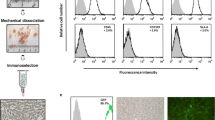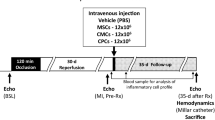Abstract
Background
Quantification of acute myocardial retention and lung bio-distribution of cardiosphere-derived cells (CDCs) following transplantation is important to improve engraftment.
Methods and results
We studied acute(1 hour) cardiac/lung retention in 4 groups (n = 25) of rats (normal—NL, acute ischemia-reperfusion—AI-RM, acute permanent ligation—PL, and chronic infarct by ischemia-reperfusion—CI-R) using intra-myocardial delivery, 1 group using intracoronary delivery (acute ischemia-reperfusion, AI-RC, n = 5) and 1 group using intravenous delivery (acute ischemia-reperfusion, AI-RV, n = 5) of CDCs by PET. Cardiac retention was similar in the NL, AI-RM, CI-R, and A-IRC groups (13.6% ± 2.3% vs 12.0% ± 3.9% vs 9.9 ± 2.8 vs 15.4% ± 5.5%; P = NS), but higher in PL animals (22.9% ± 5.2%; P < .05). Low cardiac retention was associated with significantly higher lung activity in NL and AI-RM groups (43.3% ± 5.6% and 39.9% ± 9.3%), compared to PL (28.5% ± 5.9%), CI-R (20.2% ± 9.3%), and A-IRC (19.9% ± 5.6%) animals (P < .05 vs AI-RM and NL). Lung activity was highest following intravenous CDC delivery (55.1% ± 9.3%, P < .001) and was associated with very low cardiac retention (0.8% ± 1.06%). Two-photon microscopy indicated that CDCs escaped to the lungs via the coronary veins following intra-myocardial injection.
Conclusions
Acute cardiac retention and lung bio-distribution vary with the myocardial substrate and injection route. Intra-myocardially injected CDCs escape into the lungs via coronary veins, an effect that is more pronounced in perfused myocardium.




Similar content being viewed by others
References
Wu JC, Abraham MR, Kraitchman DL. Current perspectives on imaging cardiac stem cell therapy. J Nucl Med 2010;51:128S-36S.
Amado LC, Saliaris AP, Schuleri KH, St John M, Xie JS, Cattaneo S, et al. Cardiac repair with intramyocardial injection of allogeneic mesenchymal stem cells after myocardial infarction. Proc Natl Acad Sci USA 2005;102:11474-9.
Losordo DW, Schatz RA, White CJ, Udelson JE, Veereshwarayya V, Durgin M, et al. Intramyocardial transplantation of autologous CD34+ stem cells for intractable angina: A phase I/IIa double-blind, randomized controlled trial. Circulation 2007;115:3165-72.
Tse HF, Kwong YL, Chan JK, Lo G, Ho CL, Lau CP. Angiogenesis in ischaemic myocardium by intramyocardial autologous bone marrow mononuclear cell implantation. Lancet 2003;361:47-9.
Hofmann M, Wollert KC, Meyer GP, Menke A, Arseniev L, Hertenstein B, et al. Monitoring of bone marrow cell homing into the infarcted human myocardium. Circulation 2005;111:2198-202.
Suzuki K, Murtuza B, Beauchamp JR, Brand NJ, Barton PJ, Varela-Carver A, et al. Role of interleukin-1beta in acute inflammation and graft death after cell transplantation to the heart. Circulation 2004;110:II219-24.
Smith RR, Barile L, Cho HC, Leppo MK, Hare JM, Messina E, et al. Regenerative potential of cardiosphere-derived cells expanded from percutaneous endomyocardial biopsy specimens. Circulation 2007;115:896-908.
Terrovitis J, Lautamaki R, Bonios M, Fox J, Engles JM, Yu J, et al. Noninvasive quantification and optimization of acute cell retention by in vivo positron emission tomography after intramyocardial cardiac-derived stem cell delivery. J Am Coll Cardiol 2009;54:1619-26.
Kang WJ, Kang HJ, Kim HS, Chung JK, Lee MC, Lee DS. Tissue distribution of 18F-FDG-labeled peripheral hematopoietic stem cells after intracoronary administration in patients with myocardial infarction. J Nucl Med 2006;47:1295-301.
Davis DR, Zhang Y, Smith RR, Cheng K, Terrovitis J, Malliaras K, et al. Validation of the cardiosphere method to culture cardiac progenitor cells from myocardial tissue. PloS one 2009;4:e7195.
Terrovitis J, Stuber M, Youssef A, Preece S, Leppo M, Kizana E, et al. Magnetic resonance imaging overestimates ferumoxide-labeled stem cell survival after transplantation in the heart. Circulation 2008;117:1555-62.
Dawn B, Stein AB, Urbanek K, Rota M, Whang B, Rastaldo R, et al. Cardiac stem cells delivered intravascularly traverse the vessel barrier, regenerate infarcted myocardium, and improve cardiac function. Proc Natl Acad Sci USA 2005;102:3766-71.
Helmchen F, Denk W. Deep tissue two-photon microscopy. Nat Methods 2005;2:932-40.
Honig MG, Hume RI. Fluorescent carbocyanine dyes allow living neurons of identified origin to be studied in long-term cultures. J Cell Biol 1986;103:171-87.
Schlegel JU. Demonstration of blood vessels and lymphatics with a fluorescent dye in ultraviolet light. Anat Rec 1949;105:433-43. incl 2 pl.
Hou D, Youssef EA, Brinton TJ, Zhang P, Rogers P, Price ET, et al. Radiolabeled cell distribution after intramyocardial, intracoronary, and interstitial retrograde coronary venous delivery: Implications for current clinical trials. Circulation 2005;112:I150-6.
Anderl JN, Robey TE, Stayton PS, Murry CE. Retention and biodistribution of microspheres injected into ischemic myocardium. J Biomed Mater Res A 2009;88:704-10.
Grossman PM, Han Z, Palasis M, Barry JJ, Lederman RJ. Incomplete retention after direct myocardial injection. Catheter Cardiovasc Interv 2002;55:392-7.
Teng CJ, Luo J, Chiu RC, Shum-Tim D. Massive mechanical loss of microspheres with direct intramyocardial injection in the beating heart: Implications for cellular cardiomyoplasty. J Thorac Cardiovasc Surg 2006;132:628-32.
Andersen KS, Skjerven R, Lekven J. Stability of 8-, 15-, and 26-micron microspheres entrapped in feline myocardium. Am J Physiol 1983;244:H121-30.
Altman PA, Sievers R, Lee R. Exploring heart lymphatics in local drug delivery. Lymphat Res Biol 2003;1:47-53. discussion 4.
Ludwig J. Trapping of calibrated microspheres in rat lymph nodes. Lymphology 1971;4:18-24.
Castronuovo JJ Jr, Lopez-Majano V, Flanigan P, Schuler JJ, Jonasson O. Cardiovascular lymphoscintigraphy. Surgery 1983;94:351-7.
Blocklet D, Toungouz M, Berkenboom G, Lambermont M, Unger P, Preumont N, et al. Myocardial homing of nonmobilized peripheral-blood CD34+ cells after intracoronary injection. Stem Cells 2006;24:333-6.
Johnston PV, Sasano T, Mills K, Evers R, Lee ST, Smith RR, et al. Engraftment, differentiation, and functional benefits of autologous cardiosphere-derived cells in porcine ischemic cardiomyopathy. Circulation 2009;120:1075-83. 7 p following 83.
Henquell L, LaCelle PL, Honig CR. Capillary diameter in rat heart in situ: Relation to erythrocyte deformability, O2 transport, and transmural O2 gradients. Bibliotheca anatomica 1977:416-9.
Brown SP, Miller WC, Eason JM. Exercise physiology: Basis of human movement in health and disease. Baltimore: Lippincott Williams & Wilkins; 2006.
Hare JM, Traverse JH, Henry TD, Dib N, Strumpf RK, Schulman SP, et al. A randomized, double-blind, placebo-controlled, dose-escalation study of intravenous adult human mesenchymal stem cells (prochymal) after acute myocardial infarction. J Am Coll Cardiol 2009;54:2277-86.
Lee RH, Pulin AA, Seo MJ, Kota DJ, Ylostalo J, Larson BL, et al. Intravenous hMSCs improve myocardial infarction in mice because cells embolized in lung are activated to secrete the anti-inflammatory protein TSG-6. Cell Stem Cell 2009;5:54-63.
Coffman JD, Gregg DE. Reactive hyperemia characteristics of the myocardium. Am J Physiol 1960;199:1143-9.
Feygin J, Mansoor A, Eckman P, Swingen C, Zhang J. Functional and bioenergetic modulations in the infarct border zone following autologous mesenchymal stem cell transplantation. Am J Physiol Heart Circ Physiol 2007;293:H1772-80.
Acknowledgments
We are grateful to Dana Kemmer for administrative assistance, Michelle Leppo, BS and Junaid M. Afzal, MBBS, MS for help with experiments.
Disclosures
Dr. Eduardo Marbán is founder and equity holder of Capricor, Inc. that works on CDCs. Capricor provided no funding for the present study. The remaining authors report no conflicts.
Author information
Authors and Affiliations
Corresponding author
Additional information
Michael Bonios and John Terrovitis equally contributed to this work.
This study was supported by the WW Smith Foundation (West Conshohocken, PA) (MRA), Donald W Reynolds Foundation (Las Vegas, NV), AHA (Dallas, TX) (MRA), Maryland TEDCO (Columbia, MD) (MRA), NIH RO1 HL092985 (Bethesda, MD) (MRA and FB).
Electronic supplementary material
Below is the link to the electronic supplementary material.
Rights and permissions
About this article
Cite this article
Bonios, M., Terrovitis, J., Chang, C.Y. et al. Myocardial substrate and route of administration determine acute cardiac retention and lung bio-distribution of cardiosphere-derived cells. J. Nucl. Cardiol. 18, 443–450 (2011). https://doi.org/10.1007/s12350-011-9369-9
Received:
Accepted:
Published:
Issue Date:
DOI: https://doi.org/10.1007/s12350-011-9369-9




